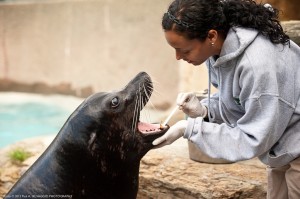
©PaulSelvaggio
Investigators
Michelle Farmerie MAIS
Henry Kacprzyk
Kesha Phares
Pittsburgh Zoo & PPG Aquarium
Project Description
Previous serum and saliva cortisol studies have been performed in California sea lions (Zalophus californianus) demonstrating that this species exhibits a correlation of cortisol across these measures and that salivary assays are effective. Although sea lions have previously been studied using salivary cortisol, the relationship between diurnal patterns of cortisol and alpha amylase has not been identified. In 2012, 0.4 California sea lions were to be relocated from the Pittsburgh Zoo & PPG Aquarium to The Smithsonian’s National Zoo. 1.3 sea lions of the original Pittsburgh group (1.7 animals total) were to remain in Pittsburgh. This provided the ideal opportunity to first identify and then establish baselines for cortisol and alpha amylase in 1.3 California sea lions at Pittsburgh and then monitor these analytes in 1.3 animals during the day of the relocation and immediately after. In the months after the relocation, collecting data from all 1.7 animals will provide a better understanding of how relocation of animals effects the entire social group. The evaluation of changes in analytes in response to the stress of the relocation will provide valuable information that could contribute to the enhanced health, welfare and captive management of the species.
